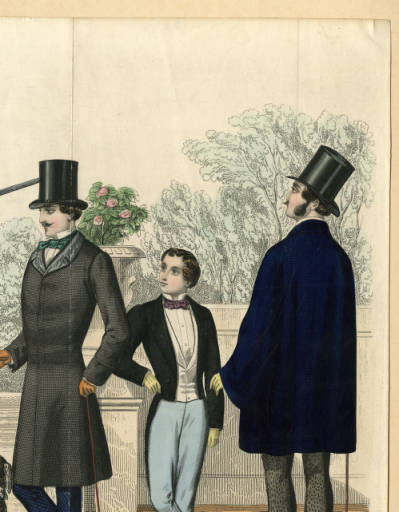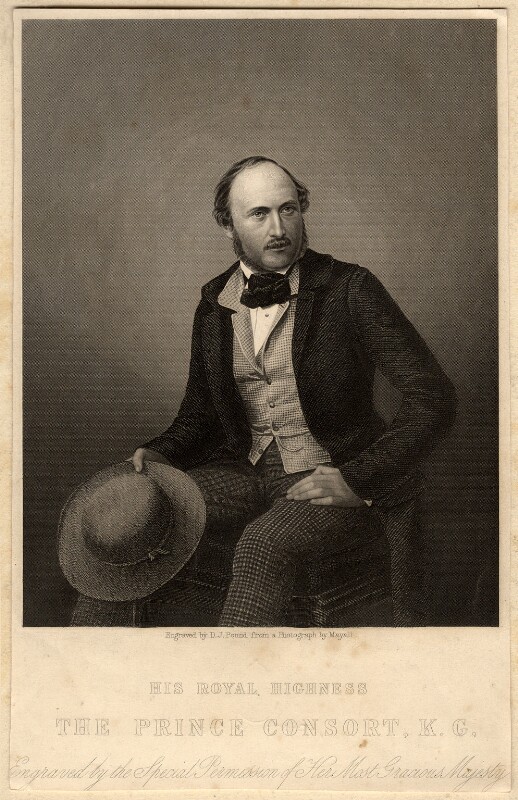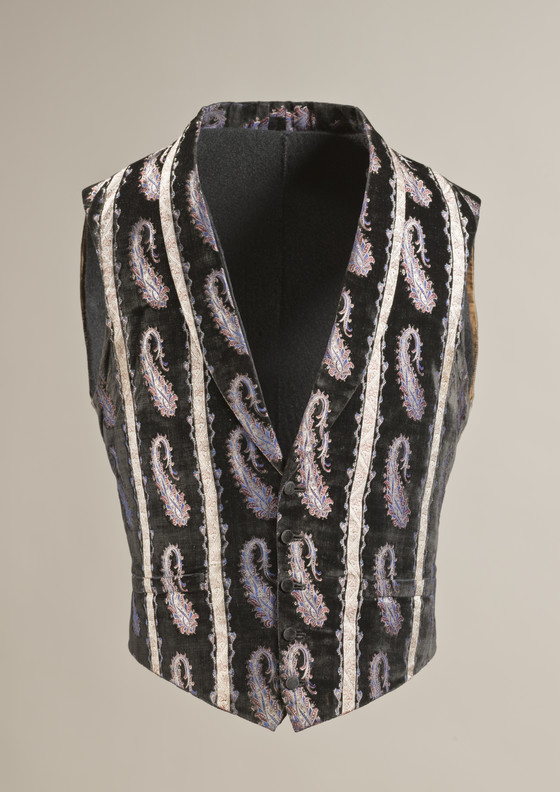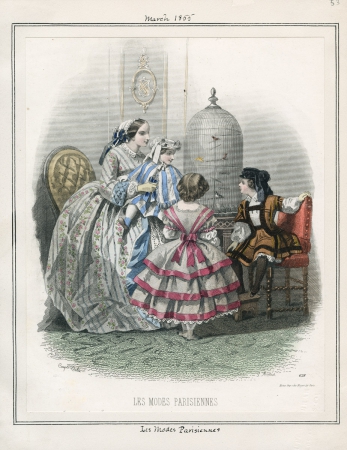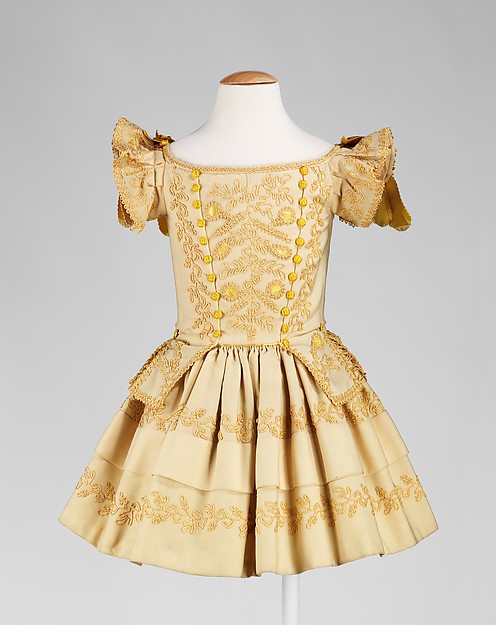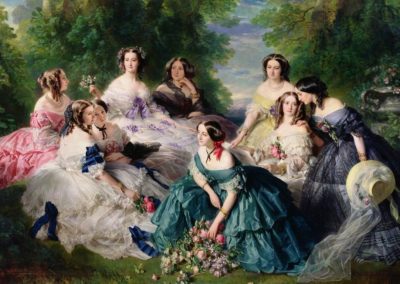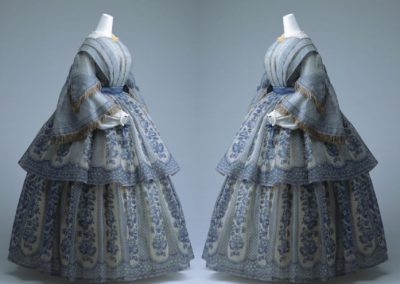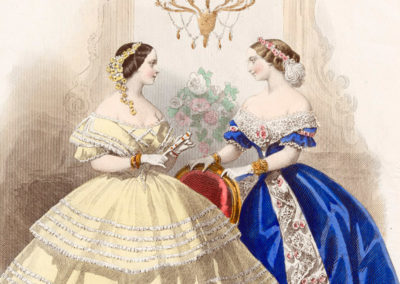OVERVIEW
Women’s fashion was ornate above all else in 1855, with the hoop skirt reigning prominently in conjunction with brightly colored silks and satins accessorized with all varieties of tasteful trimmings.
Womenswear
A fashion article from Graham’s Magazine ponders whether the fashions of the year 1855 have evolved as dramatically as other magazines, such as the Moniteur de la mode, might like readers to believe, asking:
“Have the fashions changed? That is the question. Have they had time in Paris, in the midst of the grand military reviews and preparations – in the midst of changes in helmets and uniforms – to issue orders and proclamations concerning the fashions, and to compose and conceive new bonnets and new cloaks? Fortunately, the Parisians have an Empress as well as an Emperor, and she rules over the fashions, or the graces, as one of her subjects would say, not only with the scepter of imperial power, but with the despotic rule of a pretty woman.” (95)
The concept of the “pretty woman” is one of great importance, as reflected in the elaborately feminine fashions of the year. In an 1855 fashion column from Graham’s Magazine, it is explained that:
“Dress this season is most costly, perhaps never was more so; for, in addition to the richness of the materials employed, the quantity and expense of the trimmings, without which a dress cannot be made, render the winter prospects very appalling for the papas’ and husbands’ purses.” (95)
The ornate taste that had been cultivated for womenswear called for nearly every trimming possible to be added to the flounces, sleeves, and basques of garments, from frosted leather fringe to velvet ribbons to embroidery. According to a review of winter fashion from Godey’s Magazine, “evening dresses have the flounces edged with several rows of the narrowest width of black velvet ribbon” (94).
Sleeves were often trimmed to correspond with the flounce decorations, and velvet ribbon was a very popular choice for winter adornments as well as garments. In regards to the excessive use of ribbons, Godey’s Magazine writes, “Never was there a season when ribbons were more in use for dresses, mantles, even chemisettes, and undersleeves” (288). The magazine also declares that “Any young, or for that matter, elderly lady, so disposed, may easily ruin herself in ribbons; never were they so much in demand” (191).
Expensive furs were used to trim garments worn in the colder months, both as an accessory to border velvet cloaks as well as to create striped dimension on dresses, like Godey’s Magazine describes: “The fur is cut into wide strips and placed round the skirt – each strip gradually decreasing in width as it reaches the waist” (95). Dark furs, such as beaver, as opposed to the now antiquated ermine, were mainly used, as they were considered more attractive.
As for street dresses during the colder months, brightly colored tartan plaid was fashionable as shown by figure 1, either comprising the entire dress or used as a border for plain-colored frocks. Wide stripes were also a popular pattern for day dresses, as shown in figure 2. However, the tartan plaid day dresses were the most boldly colored garments for the season, as a majority of fashion plates showcased dresses that were shades of deep green, maroon, brown, black, and gray.
Fig. 1 - Designer unknown (American). Afternoon dress, ca. 1855. Silk. New York: The Metropolitan Museum of Art, 2009.300.864. Gift of Mae Schenck, 1963. Source: The Metropolitan Museum of Art
Fig. 2 - Artist unknown (French). Magasin des demoiselles, vol. 37, no. 47 (February 1, 1855). Los Angeles: Los Angeles Public Library, rbc4359. Source: Los Angeles Public Library
Fig. 3 - George Peter Alexander Healy (American, 1813-1894). Mrs. Charles Morey (Anna Chadbourne, later Mrs. David E. Hughes), 1855. Oil on canvas; 156.84 x 113.98 cm (61 3/4 x 44 7/8 in). Boston: Museum of Fine Arts, 21.2232. Ellen Kelleran Gardner Fund. Source: Museum of Fine Arts
Fig. 4 - Jean-Baptiste Frénet (French, 1814 - 1889). Portrait of Woman and Child, 1855. Photography, salted paper print; 23.6 x 17.8 cm (9 5/16 x 7 in). Washington DC: National Gallery of Art, 2007.92.4.1. Robert B. and Joyce Menschel Fund and The Sarah and William L Walton Fund. Source: National Gallery of Art
Fig. 5 - Artist unknown (French). Les Modes Parisiennes Fashion Plate, Vol. 37, no. 50 (Thursday, March 1, 1855). Los Angeles: Los Angeles Public Library, rbc4362. Source: Los Angeles Public Library
Fig. 6 - Designer unknown (French). Woman's Evening dress: Bodice and Skirt, ca. 1850-1855. Jacquard-woven silk moiré taffeta. Philadelphia: Philadelphia Museum of Art, 1926-58-1. Gift of Alice McFadden Eyre, 1926. Source: Philadelphia Museum of Art
A
s the weather grew more favorable, fabrics of both lighter weight and color rose into fashion, and dresses of summer silks and delicate, yet eye-catching, colors were popular, as shown in the yellow gown in figure 3. As explained by the Moniteur de la mode, “the furred cloak is laid aside for the scarf or small cape of embroidered velvet,” often decorated with a deep guipure (49). In the warmer weather, women also carried decorated parasols to protect themselves from the sun in order to keep their skin fashionably pale. According to Peterson’s Magazine:
“For the more elegant kinds used for the carriage, bows and ends of ribbon supply the place of tassels. The large parasols of chintz muslin with ample flounces of the same are indispensable for the country. Some fashionable ladies carry parasols made of foulard chintz patterns, and having a border edged with a very narrow fringe. These are very graceful and truly elegant.” (444)
Besides the variance in material used, as well as accompanying accessories such as parasols and bonnets, which were comprised of varying types of straw, tulle, blonde, ribbon, and flowers for the spring and summer, silhouettes for dresses in all seasons remained relatively similar. For day dresses, puffed sleeves that came to a closure at the wrist were the general silhouette, though some puffed sleeves were slashed to reveal the undersleeves, which were often embroidered. Day dresses generally had higher neckline, showcasing buttons from the waist to the throat, which can be seen in figure 4.
As for the general silhouette, skirts were growing more circular again, causing Graham’s Magazine to write, “Hoops appear to come into fashion again – for some of the skirts of the dresses in Paris have a very thin whalebone inserted in the hem” (96). Whalebone hems or not, a very large crinoline was popular. For nearly all seasons throughout the year, mantles, shawls, and scarves were tastefully comprised of varying types of white or black lace. As Harper’s Magazine states, “For mantillas, laces are extremely fashionable… they appear to admirable advantage when worn over appropriate colors – such, for instance, as lavender or pea green” (432). Judging from the above overview of the fashion for the year, it appears evident that “immense use of crinoline” was popular to make skirts very full, as explained by Godey’s Magazine (192). Numerous flounces of both the actual skirt and the underskirt were fashionable as well, adding even more volume to a lady’s dress, exemplified in figure 5.
For evening gowns, short pagoda sleeves or short puffed sleeves closed at the upper arm with a band of lace or ribbon. Waists generally ended in a point at the center front of the gown, as shown in figure 6. Ball gowns for those partaking in dancing were made of light weight luxurious silks and satins, regardless of the weather so as to be breathable for the wearer. Necklines typically skimmed the shoulders and were cut in a V-shape, as shown in figures 7 and 8.
Fig. 7 - Franz Xaver Winterhalter (German, 1805-73). Queen Victoria, 1855. Pencil, watercolour and bodycolour; 38.3 x 26.7 cm (15.08 x 10.5 in). London: Royal Collection Trust, RCIN 913344. Source: Royal Collection Trust
Fig. 8 - Photographer unknown (American). Mme. Clara M. Brinkerhoff, ca. 1855-1865. Glass, wet collodion. Washington DC: Library of Congress, LC-BH82- 5309 B. Source: Library of Congress
Fig. 9 - Ángel María Cortellini (Spanish, 1819-1887). Portrait of a Lady, 1855. Oil on canvas; 226.5 × 141.5 cm (89.17 x 55.7 in). Bilbao: Bilbao Fine Arts Museum. Source: Wikimedia Commons
Thus, it seems evident that Ángel María Cortellini’s Portrait of a Lady, features an indisputably fashionable woman bedecked for a summer ball (Fig. 9). Her vibrant dress is comprised of high quality silk or satin, brightly colored in accordance with the season, and her large skirt as well as the V-cut of her dress prove her silhouette to be in style. The featured lady’s gown ends in a point at the center front waist, a trend previously discussed, and her short puffed sleeves are frilled with lace. The skirt of her gown is not only features the fashionable layering of flounces, but each flounce is decorated with ribbon and trimmed with lace. Therefore, she seems to be the epitome of the fashionable woman ready for a ball in her elegant, though over-the-top gown.
Menswear
Fig. 1 - Nadar (Gaspard Félix Tournachon) (French, 1820 - 1910). [Eugène] Lemaitre, ca. 1855-1859. Salted paper print; 21.1 × 15.9 cm (8 5/16 × 6 1/4 in). Los Angeles: The J. Paul Getty Museum, 84.XM.436.312. Source: The J. Paul Getty Museum
Fig. 2 - Artist unknown (British). Gentlemen's attire, Gentlemen's Magazine, September 1855. Los Angeles: Claremont Colleges Digital Library, fpc00634.tif. Source: Claremont Colleges Digital Library
Fig. 3 - Daniel John Pound (British, 1842-1877). Prince Albert of Saxe-Coburg-Gotha, 1855. Stipple engraving; 27.6 x 17.78 cm (10 7/8 in x 7 in). London: National Portrait Gallery, NPG D10866. Given by W.M. Campbell Smyth, 1935. Source: National Portrait Gallery
Fig. 4 - Designer unknown (British). Man's Vest, ca. 1855. Silk cut and voided velvet on satin. Los Angeles: Los Angeles County Museum of Art, M.2007.211.821. Purchased with funds provided by Suzanne A. Saperstein and Michael and Ellen Michelson. Source: Los Angeles County Museum of Art
CHILDREN’S WEAR
Fig. 1 - Artist unknown. Untitled, ca. 1850-1855. Daguerreotype; 6.7 x 5.4 cm (2 5/8 x 2 1/8 in). New York: Museum of Modern Art, 72.1974. Gift of Celeste Bartos. Source: Museum of Modern Art
Fig. 2 - Artist unknown (French). Les Modes Parisiennes: Childrenswear, Vol. 37, no. plate 53 (Thursday, March 1, 1855). Los Angeles: Los Angeles Public Library, rbc4365. Source: Los Angeles Public Library
Fig. 3 - James Campbell (British, 1828–1893). The Lollipop, 1855. Oil on canvas. London: The Tate Museum. Source: The Tate Museum
Fig. 4 - Designer unknown (American). Child's dress, 1855. Wool and silk. New York: The Metropolitan Museum of Art, 2009.300.686a, b. Gift of the Brooklyn Museum, 2009. Source: The Metropolitan Museum of Art
References:
- Godey’s Lady’s Book and Magazine. Vol. 51. Philadelphia: Louis A. Godey, 1855. https://hdl.handle.net/2027/mdp.39015027389413.
- Godey’s Lady’s Book and Magazine. Vol. 52–53. Philadelphia: Godey Company, 1855. https://books.google.com/books?id=R8dMAAAAMAAJ&printsec=frontcover&source=gbs_ge_summary_r&cad=0#v=onepage&q&f=false.
- Graham’s Magazine. G.R. Graham, 1855. https://books.google.com/books?id=R6jPAAAAMAAJ&printsec=frontcover&source=gbs_ge_summary_r&cad=0#v=onepage&q&f=false.
- Harper’s New Monthly Magazine. Vol. 11. New York: Harper & Brothers, 1855. https://books.google.com/books?id=C3cCAAAAIAAJ&printsec=frontcover&source=gbs_ge_summary_r&cad=0#v=onepage&q&f=false.
- Moniteur de la mode. Paris, 1855. https://books.google.com/books?id=QHMOAAAAQAAJ&printsec=frontcover&source=gbs_ge_summary_r&cad=0#v=onepage&q&f=false.
- Peterson’s Magazine. Vol. 27–28. Philadelphia: C. J. Peterson, 1855. https://hdl.handle.net/2027/njp.32101076519865.
Historical Context
Wikipedia: 1850-1859
Rulers:
- England: Queen Victoria (1837-1901)
- France: Napoleon III (1852-1870)
- Spain: Queen Isabella II (1833-1868)
- United States:
- Franklin Pierce (1853-1857)
Map of Europe in 1855. Source: Wikimedia
Events:
- The Exposition Universelle officially opened in Paris.
- Stamps were no longer taxed in The United Kingdom, allowing newspapers to be more popularly bought and sold, promoting the rise of mass media communication.
- Henry Bessemer also filed a patent for his Bessemer steel-making process in the United Kingdom, promoting industrial growth.
- In the United States, violence over slavery breaks out in the struggle known as “Bleeding Kansas.”
Timeline Entries
Primary/Period Sources
Resources for Fashion History Research
To discover primary/period sources, explore the categories below.
Have a primary source to suggest? Or a newly digitized periodical/book to announce? Contact us!
Fashion Plate Collections (Digitized)
- Costume Institute Fashion Plate collection
- Casey Fashion Plates (LA Public Library) - search for the year that interests you
- New York Public Library:
NYC-Area Special Collections of Fashion Periodicals/Plates
- FIT Special Collections (to make an appointment, click here)
- Journal des demoiselles (vol. 19-60, 1851-1892, with gaps) – AP20.J76
- Costume Institute/Watson Library @ the Met (register here)
- New York Public Library
- Brooklyn Museum Library (email for access)
Fashion Periodicals (Digitized)
Etiquette Books (Digitized)
Secondary Sources
Also see the 19th-century overview page for more research sources... or browse our Zotero library.


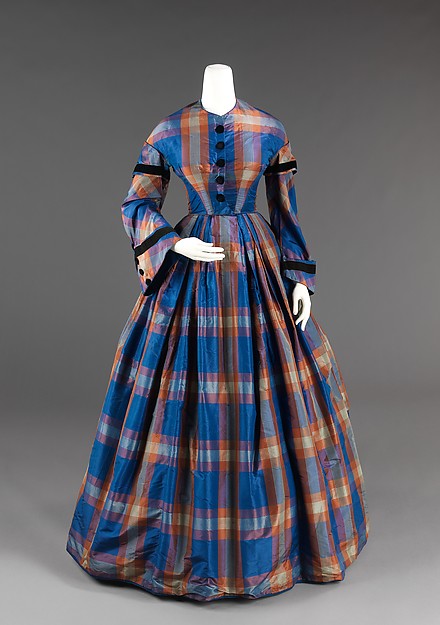

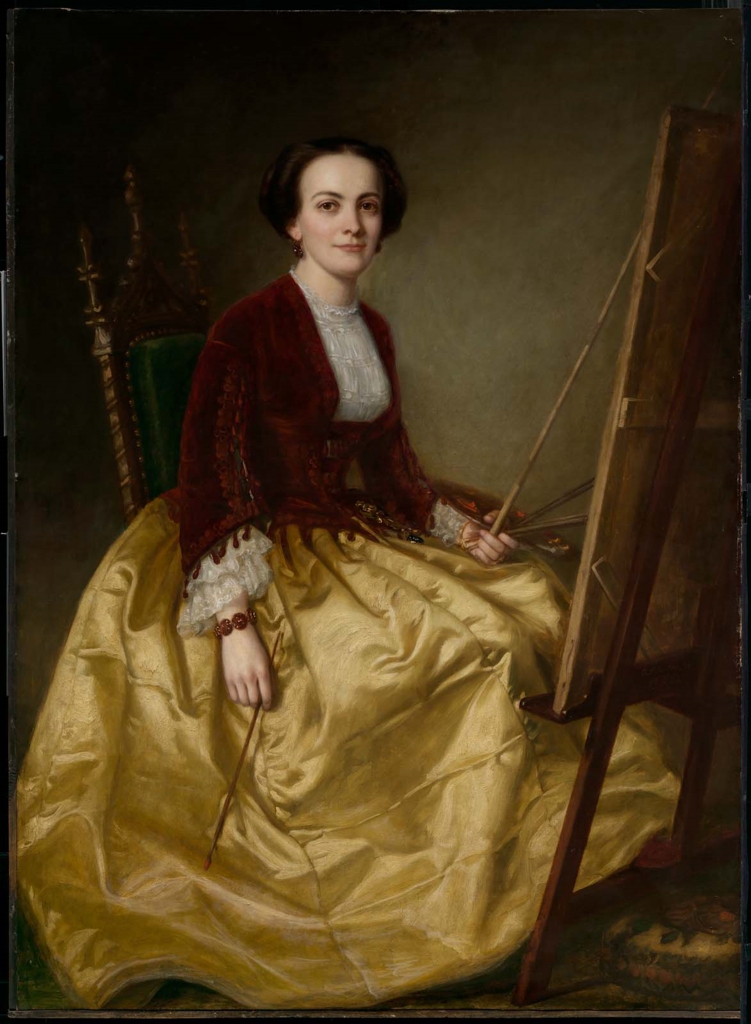

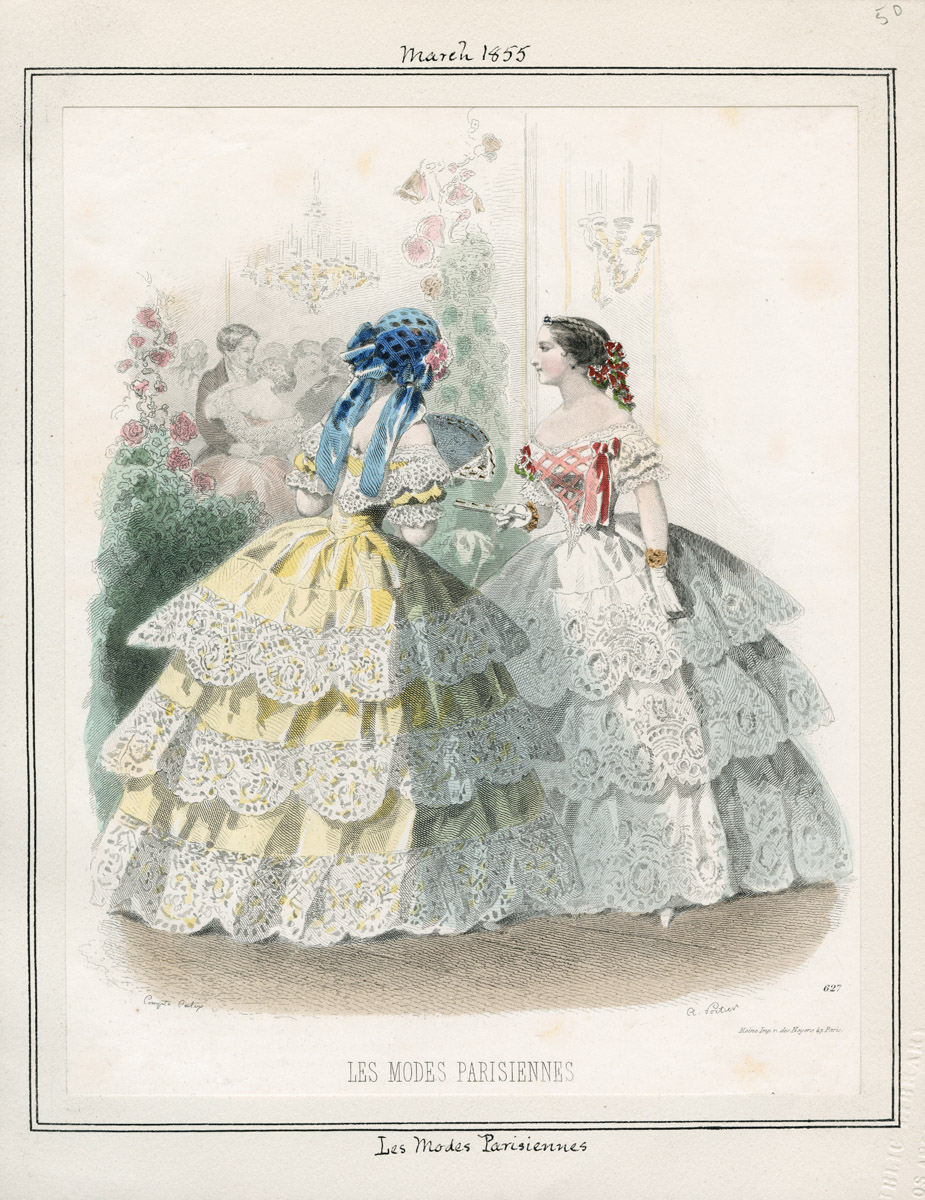
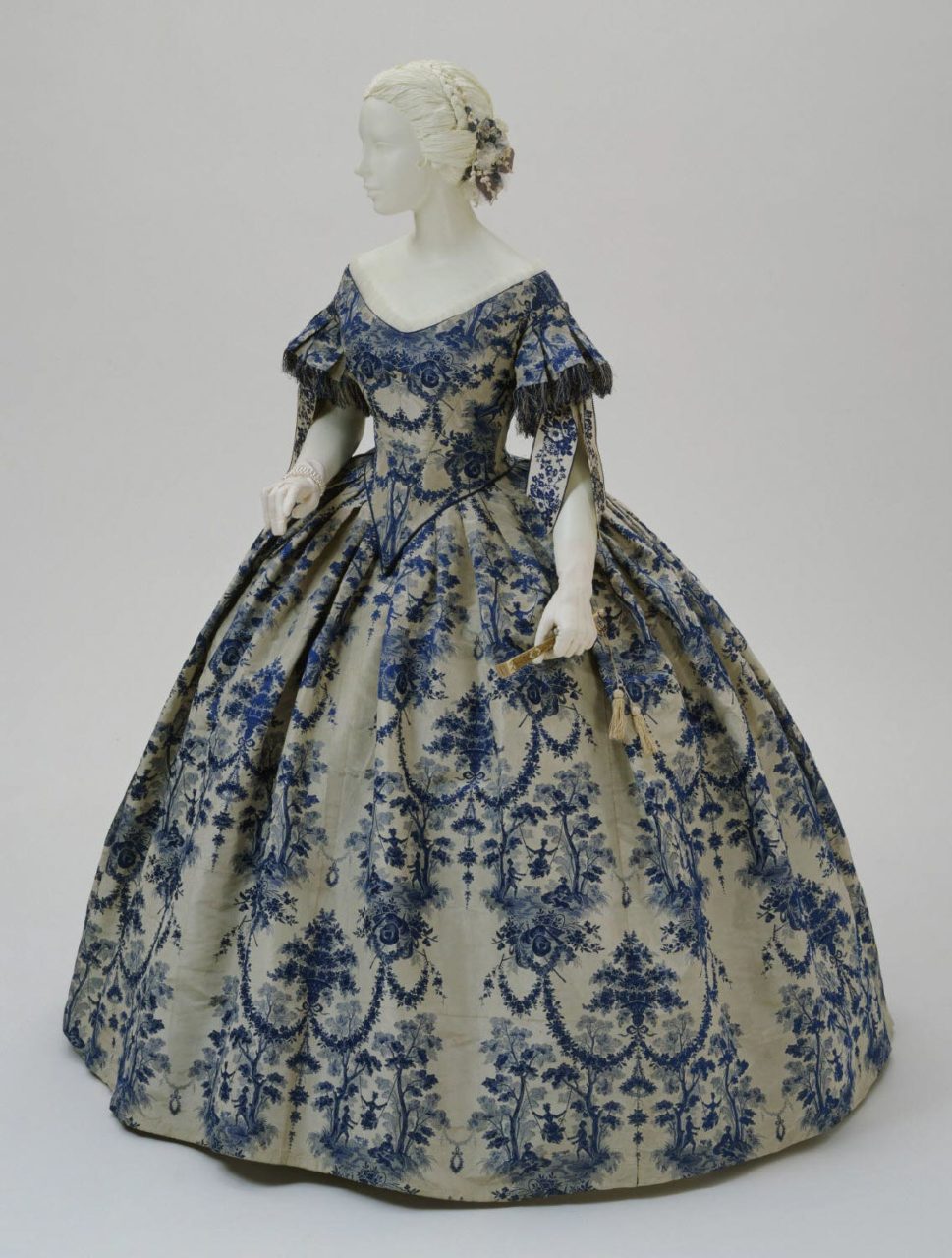

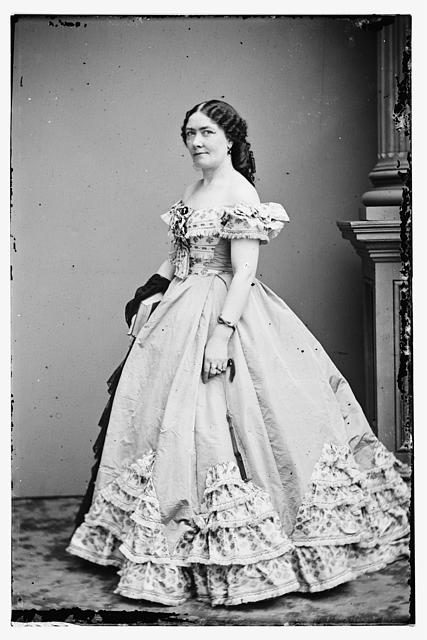
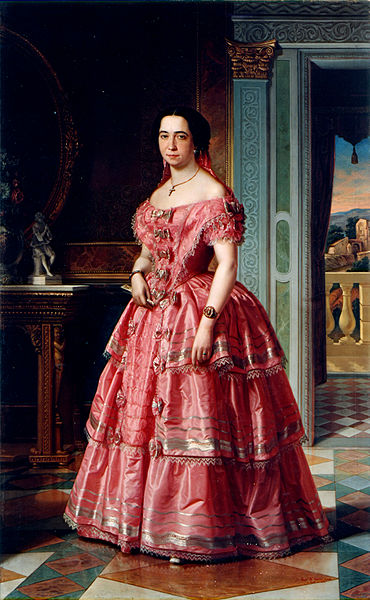
![[Eugène] Lemaitre [Eugène] Lemaitre](https://fashionhistory.fitnyc.edu/wp-content/uploads/2018/03/nadar.jpg)
